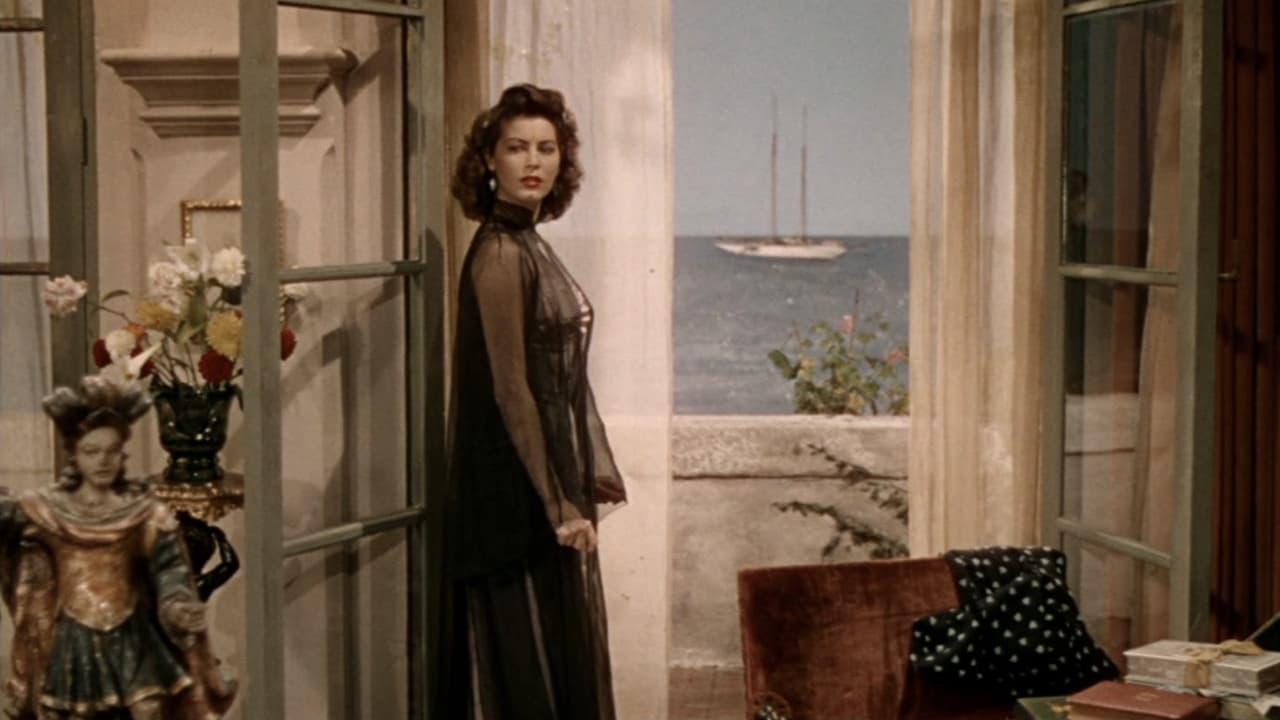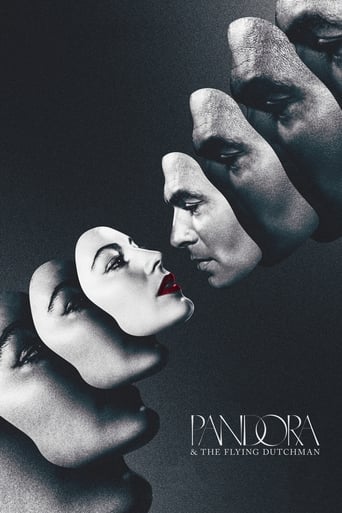

I've always liked both Ava Gardner and James Mason, who, together, form a memorable duo. However, the movie wastes their considerable talent and star quality. "Pandora" is a singularly overheated take on the Flying Dutchman legend, overflowing with colour ! passion ! thrills ! romance ! music ! exotic scenery ! (I'm adding the exclamation marks because, basically, this is what the movie itself does, all of the time.) "Pandora" is not only overheated, it is also deeply confused. You get large dollops of Christian religion and theology, ancient myth, musings about Feminity, famous poetry and so on : it is all thrown together without much taste or discernment.Some suspense, or some sense of suspense, might have helped, but sadly the title and the first ten minutes or so give away most of both plot AND ending. (Who makes this kind of weird decisions ? It's pretty much like making a movie about a blind and shy heiress who finds true love in the arms of a lesbian war veteran, and then calling your movie "The story of a blind and shy heiress who finds true love in the arms of a lesbian war veteran".)There is a lot of colour in the movie, both in a factual and in a "couleur locale" sense. As befits a nicely overheated movie shot in Spain, the viewer is treated to a full collection of clichés about Spain : bull fighting, matadors, Catholicism, knives, fiery tempers, gypsies, ominous predictions above cards announcing "Death". It's somewhat like Bizet's "Carmen", minus the wit, imagination and relevance.I'm still throwing the movie five stars - but this is mainly because I like both Gardner and Mason. We've all got our weaknesses...A small cultural note : here in Belgium too we are familiar with the "Flying Dutchman" legend. However, the version I've heard was quite different from the one shown in the movie. In this version, the captain of a ship was punished for sailing (meaning working) on a Good Friday, which should be a universally respected day of rest and meditation. He is now doomed to navigate his impious ship for all eternity...
... View MoreA beautiful 1951 fantasy. James Mason plays the Flying Dutchman-Hendrik van der Zee--who is doomed to sail the seas until he finds a woman who will die for him. He meets gorgeous Pandora Reynolds (Ava Gardner) who happens to look just like his dead wife...but he won't tell her he's a ghost. Naturally she falls for him.The plot is predictable and silly (even for a fantasy) and the dialogue is terrible--people make speeches and verbalize ALL their feelings. The pace is also way too slow and they throw in a silly subplot about bullfighter Juan Motalvo (badly played by Mario Cabre). But the film is absolutely beautiful to watch. The colors are deep and rich and every frame is like a beautiful picture. Gardner and Mason were young and look impossibly beautiful. Some of their shots took my breath away! It was shot in Spain and the settings were gorgeous. Also it's beautifully directed and has a wonderful score. Gardner and Mason are as good as anyone can be in this and everybody else--save for Cabre--are very good. So it's beautiful to watch but the silly dialogue (no one talks like the people here) and slow pace made this hard to sit through.
... View MoreA 1930s Spanish seaport is riveted by alluring saloon singer Ava Gardner (as Pandora Reynolds). A strange yacht brings intriguing "Flying Dutchman" James Mason (as Hendrik van der Zee) into her life. She drifts from Nigel Patrick (as Stephen Cameron) to Mr. Mason. Mason's wife Pamela Kellino (as Jenny) keeps an eye on the co-stars. While the original Pandora's box contained hope, Ms. Gardner's holds desire. She is beautiful and bewitching in Technicolor. Alas, the pace is funereal rather than mysterious; sometimes, it feels like the film is running in slow-motion. Gardner and the location photography by Jack Cardiff are the main attractions.***** Pandora and the Flying Dutchman (2/51) Albert Lewin ~ Ava Gardner, James Mason, Nigel Patrick, Sheila Sim
... View MoreI like to see giddy romantic movies where those on screen lives beyond my wildest dreams, or the wildest dreams of most people. A perfectly delicious and contentedly cruel Pandora (Ava Gardner) here lives the great life, she has both the world land speed record holder and Spain's champion bullfighter after her, both of whom she treats callously. She's a heart-breaker with more than one suicide under her belt no doubt. She lives in Esperanza in Southern Spain, where near dusk there are soul-stirring pine-silhouetted coastlines, with turquoise beams from littoral white-sanded patches mesmerising. Though cruel she's not stupid, she's definitely perceptive emotionally and intellectually, perhaps she may be termed an ethical egoist, or Randian. In any case a very interesting character.The central message of the film which is very potent is that, "The measure of love is what one is willing to give up for it". For The Flying Dutchman, his Lazarus-like wandering of the globe can only be stopped by his falling in love with a woman who is prepared to die for him.The movie tries to portray itself as quite clever but at times falters, with a classics professor who cannot pronounce "Phoenician", and quotations from the Ruba'iyat that are a little screwy in terms of context. Additionally the Dutchman's explanation of his painting, which is a clear Di Chirico pastiche (something of a directorial trait following the Gauguin pastiche in The Moon and the Sixpence), sounds less than authoritative. Pandora's response to the Dutchman quoting the ending of Matthew Arnold's Dover Beach suggests that she hadn't fully grasped it, and he only half-grasped.On the other hand Marius Goring, who is underused, gets a good line from Webster's The Duchess of Malfi: "I know death hath ten thousand several doors / For men to take their exits; and 'tis found / They go on such strange geometrical hinges, / You may open them both ways" It probably helps if you understand that the last line is a reference to suicide versus involuntary death, which requires Dover Notes for me, and perhaps most viewers! Statues recovered from the sea remind one of the beautiful Artemision Bronze, hauled out of the Med during the era in which the movie is set. Archaeologist Geoffrey Fielding is a rather odd sort, buried amongst books and inscriptions and bizarrely aloof from the tempestuous desires of the other characters, though not out of ignorance.The occasional pseudo-literacy is perhaps at one with what is a Technicolor delirium, a film that maintains its giddiness throughout. And yet although the film is quite the most outrageous love story, Lewin does provide a brief counterpoint, when John Laurie's mechanic, quite wonderfully cocks a toast to Sheila's Sims' Janet when she epically denounces Pandora's way of life at a celebratory dinner.A feature of Technicolor films, which is always nice to see, is that the directors generally didn't take colour for granted. One trick to show off the Technicolor wares is to have grandiose flower arrangements in the movies, here in Pandora's home. I think the green-gold lining of her cloak is an unusual colour that really ravished the screen. Actually the film is rather erotic at one point (although Fielding's description of the full moon as erotic at one point is quite titter-worthy, mainly due to delivery), just after said cloak is jettisoned and Pandora swims out to the Dutchman's yacht, naked as the day she was born.The scenes that will remain in my head the most are probably the shots of revelry (coming after the Laurie toast). I think there's something quite Elysian about them, transporting even. The movie manages despite many absurdities (the Dutchman has a 17th century photograph) to hold together well, even with the central absurdity, which is that the love that Pandora has for Hendrik van der Zee, is basically groundless, we're never even shown how it came about.
... View More